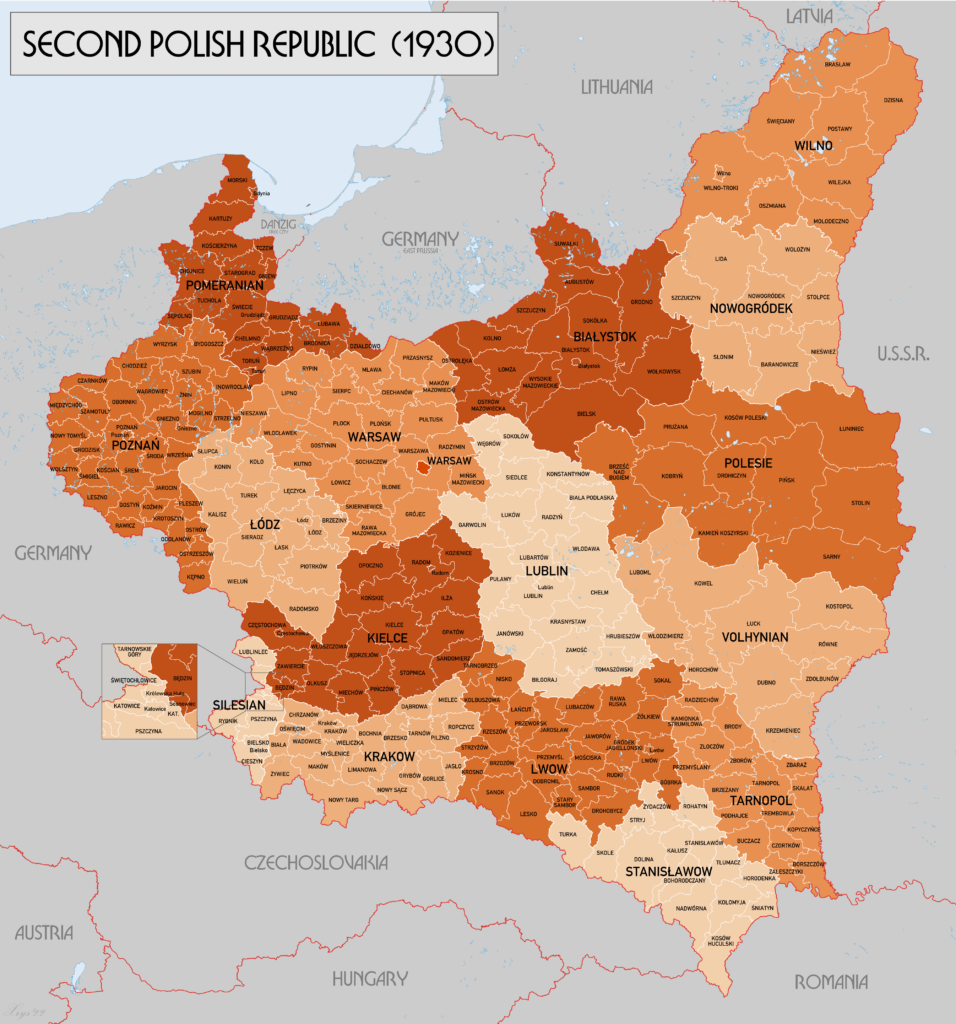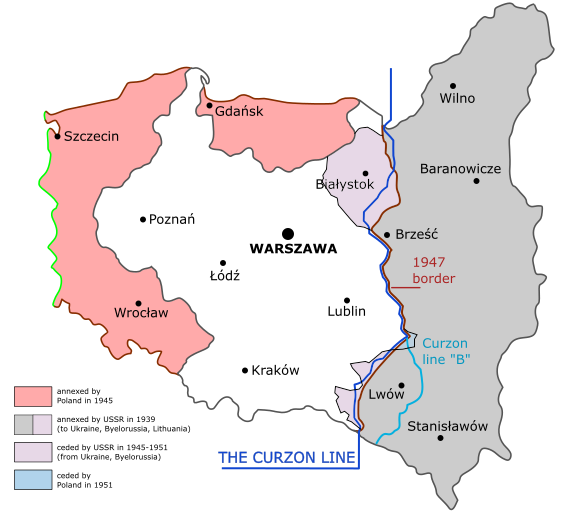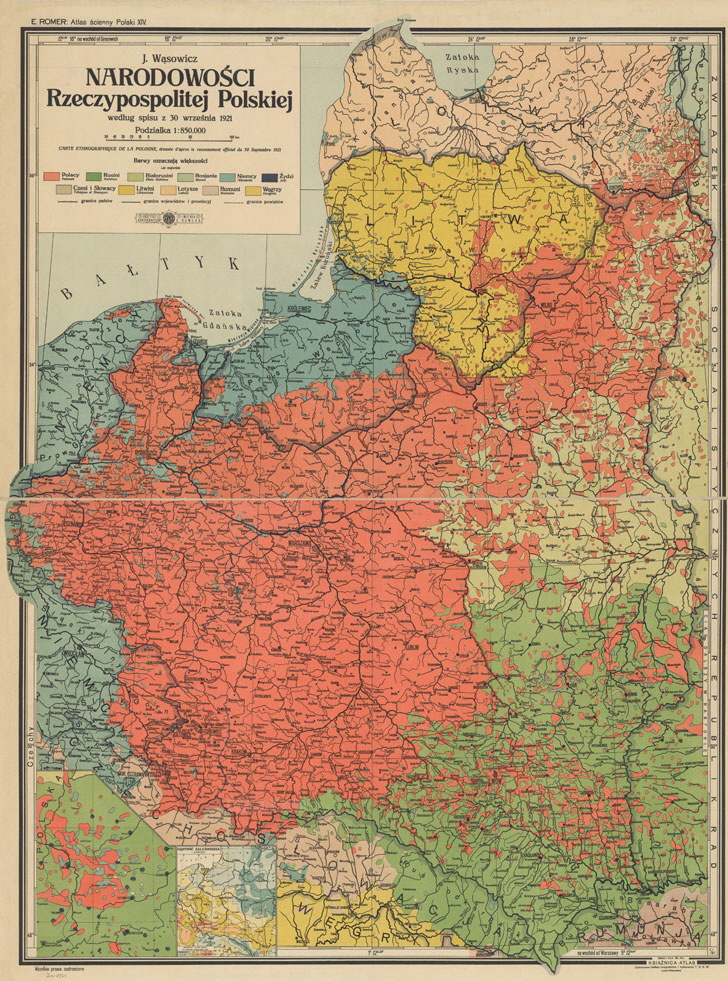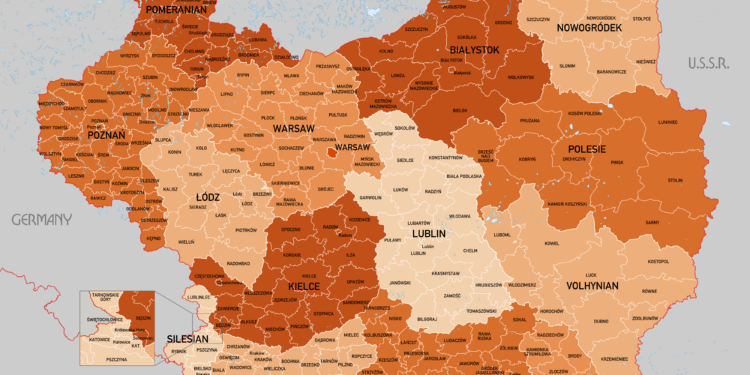In 1944, the 1st Polish Independent Parachute Brigade (1 SBSpad) landed near Oosterbeek and Driel as part of Operation Market Garden. The brigade’s men came from all over Poland or, to be precise, from the territory of the Second Polish Republic (image 1).
Shifting boundaries
After the invasion of Germany on September 1, 1939 and the Soviet Union on September 17, 1939, areas in the west and the east were annexed to Germany and the Soviet Union respectively. Naturally, the areas of the Soviet Union were occupied by the Germans in 1941 during the German attack on the Soviet Union. When Germany is defeated at the end of the war, the Soviet Union reclaims the territory conquered in 1939 and the areas are incorporated into the Soviet Socialist Republics of Ukraine, Belarus and Lithuania. To compensate, areas of Germany in the west are becoming Polish (image 2). After some ‘corrections’ in the 1950s, the national borders as we know them were created.
This means that several members of the brigade come from areas that are now part of countries such as Ukraine, Belarus, Lithuania or the Russian enclave around Kaliningrad to the north of Poland.
Victims from the Eastern Borderlands
In February 2023, Graham Francis published a list of the fallen Polish paratroopers who came from these areas in the newsletter of the Arnhem 1944 Fellowship. He entitled the article “The Ukrainian Connection.”
The list of 45* fallen soldiers includes the abbreviation KIA for ‘Killed in Action’, DoW for Died of Wounds, and AOWC for Arnhem Oosterbeek War Cemetery, also known as ‘Airborne cemetery in Oosterbeek. View the list (in PDF).
Naturally, we received permission to reuse this list.
Total share in the brigade
At the end, Graham Francis makes the following observation: Of the 97 paratroopers killed, 45* are listed as coming from areas in the east that were no longer Polish after the war. 32 of them come from what is now Ukraine. He extrapolates this and concludes that of the total brigade, about 800 men come from these areas, of which about 560 come from areas in present-day Ukraine.
What remains unmentioned is that this also applies to General Sosabowski. He is originally from Stanisławów (nowadays Ivano-Frankivsk in Ukraine). An area that was part of the Austria-Hungary Empire when he was born in 1892.
Footnote
It is good to make a comment on all these analyses. The regions we are talking about were ethnically very diverse in the years before the Second World War. Only after the war, with the shifting of borders, did population movements follow, creating more homogeneous nation states. Of course, this also plays a role in the fact that the Jewish population group, which formed a substantial share of the population before the war, was largely wiped out in the Holocaust.
Illustrative of this is the map (image 3) with the various dominant ethnic groups on the territory of the Second Polish Republic. Also interesting is the article by journalist Pieter van Os who describes how people in the region when asked about their (ethnic) origin during a census in that period indicated that they did not identify with a nation state but with the region.
From the Eastern Borderlands to Arnhem
When Germany and the Soviet Union occupied Poland in October 1939, some of these paratroopers fled to Romania and Hungary. From there, many found their way to France and Great Britain to join the Polish army.
Another important part was deported by the Soviets to labourcamps deep in the Soviet Union. Those who were not killed or survived the hardships of the camps could only join the Polish army from 1941 when the Soviet Union entered the Allied camp after Germany’s attack. Some traveled a distance of 40,000 kilometers on their way to their deployment at Oosterbeek and Driel.

Image 1: Poland and its districts in 1930
Wikipedia: By XrysD – Own work, CC BY-SA 4.0

Image 2: The shifting borders after WW2
Wikipedia: By radek.s – Own work, CC BY-SA 3.0

Image 3: Etnic diversity in Poland in 1921:
https://www.edmaps.com/html/poland_1921_c.html

